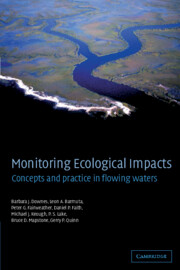Book contents
- Frontmatter
- Contents
- Preface and Acknowledgements
- Part I Introduction to the nature of monitoring problems and to rivers
- Part II Principles of inference and design
- Part III Applying principles of inference and design
- 8 Applying monitoring designs to flowing waters
- 9 Inferential uncertainty and multiple lines of evidence
- 10 Variables that are used for monitoring in flowing waters
- 11 Defining important changes
- 12 Decisions and trade-offs
- 13 Optimization
- 14 The special case of monitoring attempts at restoration
- 15 What's next?
- References
- Index
8 - Applying monitoring designs to flowing waters
Published online by Cambridge University Press: 21 August 2009
- Frontmatter
- Contents
- Preface and Acknowledgements
- Part I Introduction to the nature of monitoring problems and to rivers
- Part II Principles of inference and design
- Part III Applying principles of inference and design
- 8 Applying monitoring designs to flowing waters
- 9 Inferential uncertainty and multiple lines of evidence
- 10 Variables that are used for monitoring in flowing waters
- 11 Defining important changes
- 12 Decisions and trade-offs
- 13 Optimization
- 14 The special case of monitoring attempts at restoration
- 15 What's next?
- References
- Index
Summary
In the last chapter, we introduced the different sorts of analytical models we can use to detect impacts. There are distinct and important differences between these models, and yet understanding these differences is only the first step. The next step is to be able to apply these designs sensibly and usefully in real situations. In many cases as we will see, the ecology of streams and rivers (and, indeed, many other environments) is not sufficiently well understood to make perfect or even very good decisions about design in every instance. As we shall argue below, however, the critical issue is to understand how to make good design decisions, and, because monitoring designs always involve compromises, to be very clear and explicit about the reasoning upon which such decisions were based. The remaining part of the process, then, is to understand what monitoring designs can tell you definitively and what they cannot – what can be legitimately and logically interpreted from the data versus what will remain unclear.
Below we describe a hierarchy of decisions that will help define the nature of the problems faced in monitoring impacts in flowing waters properly. There are several problems we have to solve to apply good design principles. These problems are the location and character of control locations, and the frequency of sampling through time. In many places, we will suggest that a systematic and well-structured review of the literature will be necessary to solve these problems.
- Type
- Chapter
- Information
- Monitoring Ecological ImpactsConcepts and Practice in Flowing Waters, pp. 197 - 248Publisher: Cambridge University PressPrint publication year: 2002
- 1
- Cited by



